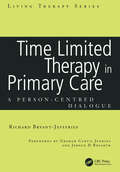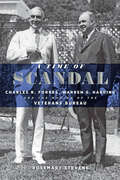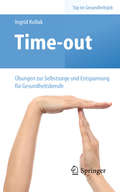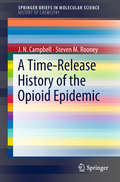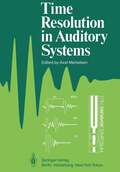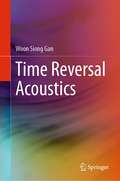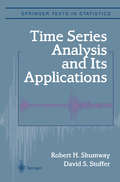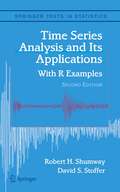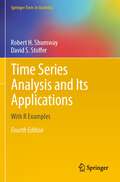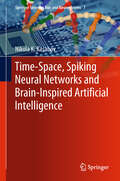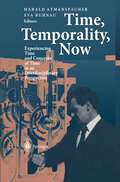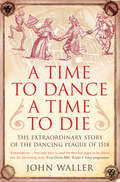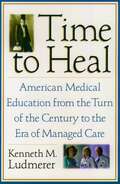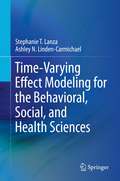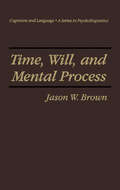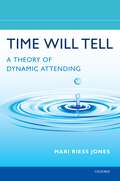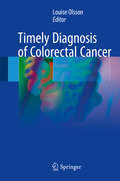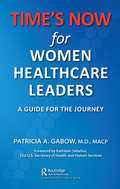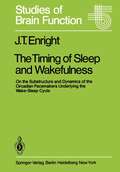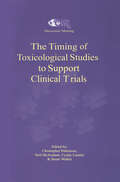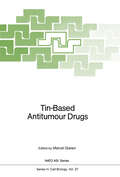- Table View
- List View
Time Limited Therapy in Primary Care: A Person-Centred Dialogue (Living Therapies Series)
by Richard Bryant-Jefferies"Many counsellors who work in primary care find it difficult to explain to colleagues in the primary care team what they actually do with clients behind the closed door of their room. In this book the author brings to life in a gripping way what really does go on when a counsellor sees a patient in the primary healthcare setting. It’s good to read for once a book that describes so realistically and movingly the minute-by-minute account of what actually happens, not a book describing clever therapists getting it right all the time. The book should be required reading for newly appointed non-clinical managers of counselling services and for primary healthcare staff about to start working with a counsellor as a member of their team."— Graham Curtis Jenkins in his Foreword
Time Limited Therapy in Primary Care: A Person-Centred Dialogue (Living Therapies Series)
by Richard Bryant-Jefferies"Many counsellors who work in primary care find it difficult to explain to colleagues in the primary care team what they actually do with clients behind the closed door of their room. In this book the author brings to life in a gripping way what really does go on when a counsellor sees a patient in the primary healthcare setting. It’s good to read for once a book that describes so realistically and movingly the minute-by-minute account of what actually happens, not a book describing clever therapists getting it right all the time. The book should be required reading for newly appointed non-clinical managers of counselling services and for primary healthcare staff about to start working with a counsellor as a member of their team."— Graham Curtis Jenkins in his Foreword
A Time of Scandal: Charles R. Forbes, Warren G. Harding, and the Making of the Veterans Bureau
by Rosemary StevensIn the early 1920s, with the nation still recovering from World War I, President Warren G. Harding founded a huge new organization to treat disabled veterans: the US Veterans Bureau, now known as the Department of Veterans Affairs. He appointed his friend, decorated veteran Colonel Charles R. Forbes, as founding director. Forbes lasted in the position for only eighteen months before stepping down under a cloud of criticism and suspicion. In 1926;¢;‚¬;€?after being convicted of conspiracy to defraud the federal government by rigging government contracts;¢;‚¬;€?he was sent to Leavenworth Penitentiary. Although he was known in his day as a drunken womanizer, and as a corrupt, betraying toady of a weak, blind-sided president, the question persists: was Forbes a criminal or a scapegoat? Historian Rosemary Stevens tells Forbes;€™s story anew, drawing on previously untapped records to reveal his role in America;€™s initial and ongoing commitment to veterans. She explores how Forbes;€™s rise and fall in Washington illuminates President Harding;€™s efforts to bring business efficiency to government. She also examines the Veterans Bureau scandal in the context of class, professionalism, ethics, and etiquette in a rapidly changing world. Most significantly, Stevens proposes a fascinating revisionist view of both Forbes and Harding;¢;‚¬;€?and raises questions about not only the validity but the source of their respective reputations. They did not defraud the government of billions of dollars, Stevens convincingly documents, and do not deserve the reputation they have carried for a hundred years.Packed with vibrant characters;¢;‚¬;€?conniving friends, FBI agents, and rival politicians split by sectional and ideological interests as well as gamblers, revelers, and wronged wives;¢;‚¬;€?A Time of Scandal will appeal to anyone interested in political gossip, presidential politics, the "Ohio Gang," and the 1920s.
A Time of Scandal: Charles R. Forbes, Warren G. Harding, and the Making of the Veterans Bureau
by Rosemary StevensIn the early 1920s, with the nation still recovering from World War I, President Warren G. Harding founded a huge new organization to treat disabled veterans: the US Veterans Bureau, now known as the Department of Veterans Affairs. He appointed his friend, decorated veteran Colonel Charles R. Forbes, as founding director. Forbes lasted in the position for only eighteen months before stepping down under a cloud of criticism and suspicion. In 1926;¢;‚¬;€?after being convicted of conspiracy to defraud the federal government by rigging government contracts;¢;‚¬;€?he was sent to Leavenworth Penitentiary. Although he was known in his day as a drunken womanizer, and as a corrupt, betraying toady of a weak, blind-sided president, the question persists: was Forbes a criminal or a scapegoat? Historian Rosemary Stevens tells Forbes;€™s story anew, drawing on previously untapped records to reveal his role in America;€™s initial and ongoing commitment to veterans. She explores how Forbes;€™s rise and fall in Washington illuminates President Harding;€™s efforts to bring business efficiency to government. She also examines the Veterans Bureau scandal in the context of class, professionalism, ethics, and etiquette in a rapidly changing world. Most significantly, Stevens proposes a fascinating revisionist view of both Forbes and Harding;¢;‚¬;€?and raises questions about not only the validity but the source of their respective reputations. They did not defraud the government of billions of dollars, Stevens convincingly documents, and do not deserve the reputation they have carried for a hundred years.Packed with vibrant characters;¢;‚¬;€?conniving friends, FBI agents, and rival politicians split by sectional and ideological interests as well as gamblers, revelers, and wronged wives;¢;‚¬;€?A Time of Scandal will appeal to anyone interested in political gossip, presidential politics, the "Ohio Gang," and the 1920s.
Time-out: Übungen zur Selbstsorge und Entspannung für Gesundheitsberufe (Top im Gesundheitsjob)
by Ingrid KollakAlle reden über Stress, aber nur wenige kümmern sich um Abhilfe. Mit voller Kraft zu funktionieren, hat eine hohe gesellschaftliche Anerkennung, dass aber bereits jeder 20. gesunde Mensch in Deutschland dazu Aufputsch- oder Beruhigungsmittel einnimmt, wird ausgeblendet.Dieses Buch findet es höchste Zeit, "Pause machen" und Entspannen als Aktivitäten und Fähigkeiten zu verstehen, die es lohnt zu erlernen. Diese Befähigung sollte als ein Baustein der eigenen Lebenskultur verstanden werden, aber auch als ein Teil der Unternehmens- und Qualitätskultur.Pausen gehören zu jedem Spiel. Doch eine solche Zeit zum Erholen und Sammeln scheint nicht in unsere Zeit zu passen. Damit wir Pause machen, müssen wir krank sein. In diesem Buch werden Übungen vorgestellt und erklärt, die zu Hause, aber auch ebenso leicht in betrieblichen Präventionsprogrammen und in Stadtteilzentren angeboten werden können. Sie umfassen Elemente des Yoga sowie des Qi Gong und der Progressiven Muskelrelaxation.Detailliert werden die 75 Übungen mit Fotos beschrieben, die alle Regionen des Körpers ansprechen. Sie dienen zur Gesunderhaltung, sind aber auch bei Gesundheitsproblemen, wie z.B. Kopfweh, Rückenschmerzen und Schlafstörungen wirksam. Die Übungen sind auf die besonderen Belastungen in Gesundheitsberufen abgestimmt. Auch ohne sportliche Vorkenntnisse sind die Übungen individuell oder in Gruppen ohne teure Ausrüstung leicht ausführbar.
A Time-Release History of the Opioid Epidemic (SpringerBriefs in Molecular Science)
by J. N. Campbell Steven M. RooneyThis Brief takes the reader on a chemical journey by following the history for over two centuries of how an opiate became an opioid, thus spawning an empire and a series of crises. These imperfect resemblances of alkaloids are both natural and synthetic substances that, particularly in America, are continually part of a growing concern about overuse. This seemed an inviting prospect for those in pain, but as the ubiquitous media coverage continues to lay bare, the levels of abuse point to the fact that perhaps an epidemic is upon us, if not a culture war. Seeking answers to how and why this addiction crisis transpired over two hundred years of long development, this Brief examines the role that the chemistry laboratory played in turning patients into consumers. By utilizing a host of diverse sources, this Brief seeks to trace the design and the production of opioids and their antecedents over the past two centuries. From the isolation and development of the first alkaloids with morphine that relieved pain within the home and on the battlefield, to the widespread use of nostrums and the addiction crisis that ensued, to the dissemination of drugs by what became known as Big Pharma after the World Wars; and finally, to competition from home-made pharmaceuticals, the progenitor was always, in some form, a type of chemistry lab. At times, the laboratory pressed science to think deeply about society's maladies, such as curing disease and alleviating pain, in order to look for new opportunities in the name of progress. Despite the best intentions opioids have created a paradox of pain as they were manipulated by creating relief with synthetic precision and influencing a dystopian vision. Thus, influence came in many forms, from governments, from the medical community, and from the entrepreneurial aspirations of the general populace. For better, but mostly for worse, all played a role in changing forever the trajectory of what started with the isolation of a compound in Germany. Combining chemistry and history in a rousing new long-form narrative that even broadens the definition of a laboratory, the origins and future of this complicated topic are carefully examined.
Time Resolution in Auditory Systems: Proceedings of the 11th Danavox Symposium on Hearing Gamle Avernæs, Denmark, August 28–31, 1984 (Proceedings in Life Sciences)
by Axel MichelsenMany books from symposia describe the current status in well established fields of research, where much is known and where the loose ends are only details in the picture. The topic dealt with here does not fall into this pattern. The study of time as a parameter in its own right is difficult, and the loose ends tend to do minate the present picture. Although the book does provide the reader with an overview of the field, its main value is probably to act as a source of "food for thought" for those interested in the function of sense organs and nervous systems as substrates for behaviour. The Introduction is intended to provide the readers of the book with a short guide to the topiCS discussed in the different chapters. The rather detailed Index may help those looking for information on specific topiCS. The Index also explains most of the abbreviations used in the book. The basic idea of the Danavox symposia is to invite a small group of experts to discuss a rather narrow theme in sound communication. The small number of active par tiCipants has the advantage of encouraging intense dis cussions and of avoiding overloading the program. On the other hand, selecting the partiCipants is difficult.
Time Reversal Acoustics
by Woon Siong GanThis book highlights time reversal acoustics, techniques based on the symmetry properties of acoustic fields. It has the unique feature that the first eleven chapters of the book are on the indepth studies of the theories of time reversal acoustics. The remaining chapters are on the four major applications of time reversal acoustics, together with their experimental setups and case studies: underwater communication, seismic exploration,nondestructive evaluation, and medical ultrasound imaging.. The gauge invariance approach to acoustic fields, proposed by the author in 2007, is confirmed by the successful fabrication of acoustical metamaterials and the applications of time reversal acoustics to superresolution. The book also presents groundbreaking applications of time reversal acoustics to underwater communication technology and the application of metamaterials to time reversal acoustics.
Time Series Analysis and Its Applications (Springer Texts in Statistics)
by Robert H. Shumway David S. StofferA balanced and comprehensive treatment of both time and frequency domain methods with accompanying theory. Numerous examples using non-trivial data illustrate solutions to problems, such as evaluating pain perception experiments using magnetic resonance imaging or monitoring a nuclear test ban treaty. Although designed as a text for graduate level students in statistics and the physical, biological and social sciences, some parts of the book will also serve as an undergraduate introductory course. Theory and methodology are separated to allow presentations on different levels, and the material has been updated by adding modern developments involving categorical time series analysis and the spectral envelope, multivariate spectral methods, long memory series, nonlinear models, longitudinal data analysis, resampling techniques, ARCH models, stochastic volatility, wavelets and Monte Carlo Markov chain integration methods. The book is supplemented by data and an exploratory time series analysis program ASTSA for Windows that can be downloaded from the Web as freeware.
Time Series Analysis and Its Applications: With R Examples (Springer Texts in Statistics)
by Robert H. Shumway David S. StofferThe second edition marks a substantial change to the ?rst edition. P- haps the most signi?cant change is the introduction of examples based on the freeware R package. The package, which runs on most operating systems, can be downloaded from The Comprehensive R Archive Network (CRAN) at http://cran. r-project. org/ or any one of its mirrors. Readers who have experience with the S-PLUS R package will have no problem working with R. For novices, R installs some help manuals, and CRAN supplies links to contributed tutorials such as R for Beginners. In our examples, we assume the reader has downloaded and installed R and has downloaded the nec- sary data ?les. The data ?les can be downloaded from the website for the text,http://www. stat. pitt. edu/stoffer/tsa2/ or any one of its mirrors. We will also provide additional code and other information of interest on the text’s website. Most of the material that would be given in an introductory course on time series analysis has associated R code. Although examples are given in R, the material is not R-dependent. In courses we have given using a preliminary version of the new edition of the text, students were allowed to use any package of preference. Although most students used R (or S-PLUS), a number of them completed the course successfully using other programs such R R R as ASTSA, MATLAB ,SAS , and SPSS . Another substantial change from the ?rst edition is that the material has beendividedintosmallerchapters.
Time Series Analysis and Its Applications: With R Examples (Springer Texts in Statistics)
by Robert H. Shumway David S. StofferThe fourth edition of this popular graduate textbook, like its predecessors, presents a balanced and comprehensive treatment of both time and frequency domain methods with accompanying theory. Numerous examples using nontrivial data illustrate solutions to problems such as discovering natural and anthropogenic climate change, evaluating pain perception experiments using functional magnetic resonance imaging, and monitoring a nuclear test ban treaty.The book is designed as a textbook for graduate level students in the physical, biological, and social sciences and as a graduate level text in statistics. Some parts may also serve as an undergraduate introductory course. Theory and methodology are separated to allow presentations on different levels. In addition to coverage of classical methods of time series regression, ARIMA models, spectral analysis and state-space models, the text includes modern developments including categorical time series analysis, multivariate spectral methods, long memory series, nonlinear models, resampling techniques, GARCH models, ARMAX models, stochastic volatility, wavelets, and Markov chain Monte Carlo integration methods.This edition includes R code for each numerical example in addition to Appendix R, which provides a reference for the data sets and R scripts used in the text in addition to a tutorial on basic R commands and R time series. An additional file is available on the book’s website for download, making all the data sets and scripts easy to load into R.
Time-Space, Spiking Neural Networks and Brain-Inspired Artificial Intelligence (Springer Series on Bio- and Neurosystems #7)
by Nikola K. KasabovSpiking neural networks (SNN) are biologically inspired computational models that represent and process information internally as trains of spikes. This monograph book presents the classical theory and applications of SNN, including original author’s contribution to the area. The book introduces for the first time not only deep learning and deep knowledge representation in the human brain and in brain-inspired SNN, but takes that further to develop new types of AI systems, called in the book brain-inspired AI (BI-AI). BI-AI systems are illustrated on: cognitive brain data, including EEG, fMRI and DTI; audio-visual data; brain-computer interfaces; personalized modelling in bio-neuroinformatics; multisensory streaming data modelling in finance, environment and ecology; data compression; neuromorphic hardware implementation. Future directions, such as the integration of multiple modalities, such as quantum-, molecular- and brain information processing, is presented in the last chapter. The book is a research book for postgraduate students, researchers and practitioners across wider areas, including computer and information sciences, engineering, applied mathematics, bio- and neurosciences.
Time, Temporality, Now: Experiencing Time and Concepts of Time in an Interdisciplinary Perspective
by Harald Atmanspacher Eva RuhnauThe essays in this topical volume inquire into one of the most fundamental issues of philosophy and of the cognitive and natural sciences: the riddle of time. The central feature is the tension between the experience and the conceptualization of time, reflecting an apparently unavoidable antinomy of subjective first-person accounts and objective traditional science. Is time based in the physics of inanimate matter, or does it originate in the operation of our minds? Is it essential for the constitution of reality, or is it just an illusion? Issues of time, temporality, and nowness are paradigms for interdisciplinary work in many contemporary fields of research. The authors of this volume discuss profoundly the mutual relationships and inspiring perspectives. They address a general audience.
A Time to Dance, a Time to Die: The Extraordinary Story of the Dancing Plague of 1518
by John Waller‘A compelling history of workhouse children in the industrial revolution.' The Guardian ‘A compelling 'whatdunnit'’ The Times ‘Waller’s book should interest both historians and scientists, while the general reader will enjoy his colourful depictions of medieval life.’ BBC Focus Magazine This is the true story of a wild dancing epidemic that brought death and fear to a 16th-century city, and the terrifying supernatural beliefs from which it arose. In July 1518 a terrifying and mysterious plague struck the medieval city of Strasbourg. Hundreds of men and women danced wildly, day after day, in the punishing summer heat. They did not want to dance, but could not stop. Throughout August and early September more and more were seized by the same terrible compulsion. By the time the epidemic subsided, heat and exhaustion had claimed an unfold number of lives, leaving thousands bewildered and bereaved, and an enduring enigma for future generations. Drawing on fresh evidence, John Waller's account of the bizarre events of 1518 explains why Strasbourg's dancing plague took place. In doing so it leads us into a largely vanished world, evoking the sights, sounds, aromas, diseases and hardships, the fervent supernaturalism, and the desperate hedonism of the late medieval world. At the same time, the extraordinary story this book tells offers rich insights into how people behave when driven beyond the limits of endurance. Above all, A Time to Dance, a Time to Die: The Extraordinary Story of the Dancing Plague of 1518 is an exploration into the strangest capabilities of the human mind and the extremes to which fear and irrationality can lead us.
Time to Heal: American Medical Education from the Turn of the Century to the Era of Managed Care
by Kenneth M. LudmererAlready the recipient of extraordinary critical acclaim, this magisterial book provides a landmark account of American medical education in the twentieth century, concluding with a call for the reformation of a system currently handicapped by managed care and by narrow, self-centered professional interests. Kenneth M. Ludmerer describes the evolution of American medical education from 1910, when a muck-raking report on medical diploma mills spurred the reform and expansion of medical schools, to the current era of managed care, when commercial interests once more have come to the fore, compromising the training of the nation's future doctors. Ludmerer portrays the experience of learning medicine from the perspective of students, house officers, faculty, administrators, and patients, and he traces the immense impact on academic medical centers of outside factors such as World War II, the National Institutes of Health, private medical insurance, and Medicare and Medicaid. Most notably, the book explores the very real threats to medical education in the current environment of managed care, viewing these developments not as a catastrophe but as a challenge to make many long overdue changes in medical education and medical practice. Panoramic in scope, meticulously researched, brilliantly argued, and engagingly written, Time to Heal is both a stunning work of scholarship and a courageous critique of modern medical education. The definitive book on the subject, it provides an indispensable framework for making informed choices about the future of medical education and health care in America.
Time-Varying Effect Modeling for the Behavioral, Social, and Health Sciences
by Stephanie T. Lanza Ashley N. Linden-CarmichaelThis book is the first to introduce applied behavioral, social, and health sciences researchers to a new analytic method, the time-varying effect model (TVEM). It details how TVEM may be used to advance research on developmental and dynamic processes by examining how associations between variables change across time. The book describes how TVEM is a direct and intuitive extension of standard linear regression; whereas standard linear regression coefficients are static estimates that do not change with time, TVEM coefficients are allowed to change as continuous functions of real time, including developmental age, historical time, time of day, days since an event, and so forth.The book introduces readers to new research questions that can be addressed by applying TVEM in their research. Readers gain the practical skills necessary for specifying a wide variety of time-varying effect models, including those with continuous, binary, and count outcomes. The book presents technical details of TVEM estimation and three novel empirical studies focused on developmental questions using TVEM to estimate age-varying effects, historical shifts in behavior and attitudes, and real-time changes across days relative to an event. The volume provides a walkthrough of the process for conducting each of these studies, presenting decisions that were made, and offering sufficient detail so that readers may embark on similar studies in their own research. The book concludes with comments about additional uses of TVEM in applied research as well as software considerations and future directions. Throughout the book, proper interpretation of the output provided by TVEM is emphasized.Time-Varying Effect Modeling for the Behavioral, Social, and Health Sciences is an essential resource for researchers, clinicians/practitioners as well as graduate students in developmental psychology, public health, statistics and methodology for the social, behavioral, developmental, and public health sciences.
Time, Will, and Mental Process (Cognition and Language: A Series in Psycholinguistics)
by Jason W. BrownIn this volume, distinguished neurologist Jason W. Brown extends the microgenetic theory of the mind by offering a new approach to the problem of time and free will. Brown bases his work on a unitary process model of brain and behavior. He examines the problem of subjective time and free will, the experiential present, the nature of intentionality, and the creative properties of physical growth and mental process.
Time Will Tell: A Theory of Dynamic Attending
by Mari Riess JonesAttention is a central concept in psychology. The term 'attention' itself has persisted, even though it implies a static, insulated capacity that we use when it is necessary to focus upon some relevant or stimulating event. Riess Jones presents a different way of thinking about attention; one that describes it as a continuous activity that is based on energy fluctuating in time. A majority of attention research fails to examine influence of event time structure (i.e., a speech utterance) on listeners' moment-to-moment attending. General research ignores listeners endowed with innate, as well as acquired, temporal biases. Here, attending is portrayed as a dynamic interaction of an individual within his or her surroundings. Importantly, this interaction involves synchronicity between an attender and external events. This emphasis on time and synchronicity distinguishes the author's theory, called Dynamic Attending Theory (DAT), from other approaches to attending which characterize attention metaphorically as a filter, resource pool, spotlight, and so on. Recent research from neuroscience has lent support to Riess Jones' theory, and the goal of this book is to bring this new research as well as her own to the wide audience of psychologists interested in attention more broadly.
Time Will Tell: A Theory of Dynamic Attending
by Mari Riess JonesAttention is a central concept in psychology. The term 'attention' itself has persisted, even though it implies a static, insulated capacity that we use when it is necessary to focus upon some relevant or stimulating event. Riess Jones presents a different way of thinking about attention; one that describes it as a continuous activity that is based on energy fluctuating in time. A majority of attention research fails to examine influence of event time structure (i.e., a speech utterance) on listeners' moment-to-moment attending. General research ignores listeners endowed with innate, as well as acquired, temporal biases. Here, attending is portrayed as a dynamic interaction of an individual within his or her surroundings. Importantly, this interaction involves synchronicity between an attender and external events. This emphasis on time and synchronicity distinguishes the author's theory, called Dynamic Attending Theory (DAT), from other approaches to attending which characterize attention metaphorically as a filter, resource pool, spotlight, and so on. Recent research from neuroscience has lent support to Riess Jones' theory, and the goal of this book is to bring this new research as well as her own to the wide audience of psychologists interested in attention more broadly.
Timely Diagnosis of Colorectal Cancer
by Louise OlssonThis book summarizes current knowledge and outlines directions for the future on how to improve the art of diagnosing colorectal cancer with emphasis on timeliness, one of the most vital issues in cancer management. Using a comprehensive, multi-discliplinary approach, it provides an overview of decisive factors in timely diagnosis of colorectal cancer from symptom scores and symptom awareness to technical aspects. The book starts by discussing early diagnosis from the perspective of patients, including the importance of awareness in the general population as well as psychological aspects. It then goes on to discuss issues of importance to clinicians, such as fast tracking, laboratory testing, improving technical skills and optimizing endoscopy services. In addition, more practical issues such as cost-effectiveness and auditing are also extensively discussed. By focusing on one specific but common form of cancer the content translates well across the scope of other cancer types and can be used by professionals working on different cancer types.This book provides clinicians, clinical researchers and policymakers with a comprehensive overview of the field of timeliness in diagnosing colorectal cancer. By addressing the challenges posed in the management of symptomatic patients it informs and educates the experts and could help improve diagnosis.
TIME'S NOW for Women Healthcare Leaders: A Guide for the Journey
by Patricia A. GabowTIME’S NOW for Women Healthcare Leaders: A Guide for the Journey Women comprise over 80 percent of healthcare frontline employees, but they often hit the proverbial glass ceiling. Only 30 percent of healthcare C-suite Executives and less than 15% of CEOs are women. Moreover, while 51 percent of medical students are women, only 16 percent of the Department Chairs and Deans are women. Clearly, women are facing barriers to achieving their potential, limiting their ability to add their unique talents and skills to the tables of leadership. The author provides extensive detail on these barriers and approaches to their solutions. This is a practical "how-to" book that will help women in healthcare envision their ability to contribute and inspire them to lead. The author sees this as not only helping women, but also facilitating solving healthcare’s myriad problems, improving health and benefitting society. *** This book is a must-read primer for women seeking leadership. It is practical, thought provoking, and carefully researched, addressing why women’s leadership is important and how women can be better leaders. Gabow’s approach capitalizes on interviews with strong women leaders. She uses the notions she learned from the interviews coupled with research from the literature to create an easy-to-read, motivating, and challenging book for women and men! Nancy AgeePresident and CEO Carilion ClinicPast Chair American Hospital Association TIME’S NOW for Women Healthcare Leaders is filled with powerful examples of how women have overcome multiple obstacles and prevailed on their leadership journeys. It is a MUST read for women and men about the obstacles to be overcome, potholes to avoid, and the shout outs to be given to women who every minute, every hour, every day are committed to human caring. It has captured the heart and spirits of women from diverse backgrounds who have and continue to demonstrate their commitment to making society a better place for all! Linda Burnes Bolton, DrPH, RN, FAAN Senior Vice President and System Chief Equity Officer Cedars Sinai Health System This highly engaging book addresses the relative dearth of women leaders in healthcare through thoughtful assessment of how leaders’ values and actions can improve healthcare within healthcare organizations and systems. Dr. Gabow, an exceptional leader whose relentless passion for excellence for patients served by Denver Health earned her national renown, combines insightful observations from her own path with current statistics about women in medicine, experiences of other successful women leaders, and mentoring skills to offer wise counsel to all current and future leaders. The thoughtful distillation of practical wisdom offered here make this book a unique contribution and highly relevant to healthcare in America today. Carolyn Clancy, M.D. Past Director, Agency for Healthcare Research and Quality This insightful book is full of personal stories, honest reflections, and data-driven guidance from and about women leaders. It serves as a wonderful resource for those motivated to advance diverse and inclusive organizations. Karen DeSalvo, M.D., MPHChief Health Officer, Google HealthPast Acting Assistant Secretary for Health, US HHSNational Coordinator for Health Information Technology, US HHS
TIME'S NOW for Women Healthcare Leaders: A Guide for the Journey
by Patricia A. GabowTIME’S NOW for Women Healthcare Leaders: A Guide for the Journey Women comprise over 80 percent of healthcare frontline employees, but they often hit the proverbial glass ceiling. Only 30 percent of healthcare C-suite Executives and less than 15% of CEOs are women. Moreover, while 51 percent of medical students are women, only 16 percent of the Department Chairs and Deans are women. Clearly, women are facing barriers to achieving their potential, limiting their ability to add their unique talents and skills to the tables of leadership. The author provides extensive detail on these barriers and approaches to their solutions. This is a practical "how-to" book that will help women in healthcare envision their ability to contribute and inspire them to lead. The author sees this as not only helping women, but also facilitating solving healthcare’s myriad problems, improving health and benefitting society. *** This book is a must-read primer for women seeking leadership. It is practical, thought provoking, and carefully researched, addressing why women’s leadership is important and how women can be better leaders. Gabow’s approach capitalizes on interviews with strong women leaders. She uses the notions she learned from the interviews coupled with research from the literature to create an easy-to-read, motivating, and challenging book for women and men! Nancy AgeePresident and CEO Carilion ClinicPast Chair American Hospital Association TIME’S NOW for Women Healthcare Leaders is filled with powerful examples of how women have overcome multiple obstacles and prevailed on their leadership journeys. It is a MUST read for women and men about the obstacles to be overcome, potholes to avoid, and the shout outs to be given to women who every minute, every hour, every day are committed to human caring. It has captured the heart and spirits of women from diverse backgrounds who have and continue to demonstrate their commitment to making society a better place for all! Linda Burnes Bolton, DrPH, RN, FAAN Senior Vice President and System Chief Equity Officer Cedars Sinai Health System This highly engaging book addresses the relative dearth of women leaders in healthcare through thoughtful assessment of how leaders’ values and actions can improve healthcare within healthcare organizations and systems. Dr. Gabow, an exceptional leader whose relentless passion for excellence for patients served by Denver Health earned her national renown, combines insightful observations from her own path with current statistics about women in medicine, experiences of other successful women leaders, and mentoring skills to offer wise counsel to all current and future leaders. The thoughtful distillation of practical wisdom offered here make this book a unique contribution and highly relevant to healthcare in America today. Carolyn Clancy, M.D. Past Director, Agency for Healthcare Research and Quality This insightful book is full of personal stories, honest reflections, and data-driven guidance from and about women leaders. It serves as a wonderful resource for those motivated to advance diverse and inclusive organizations. Karen DeSalvo, M.D., MPHChief Health Officer, Google HealthPast Acting Assistant Secretary for Health, US HHSNational Coordinator for Health Information Technology, US HHS
The Timing of Sleep and Wakefulness: On the Substructure and Dynamics of the Circadian Pacemakers Underlying the Wake-Sleep Cycle (Studies of Brain Function #3)
by J. T. EnrightThe brain functions like a computer composed of subsystems which in teract in a hierarchical manner. But it is not a single hierarchy, but a com plex system of hierarchies each of which has its very own and unique fea ture. One of these concerns the cyclic or rhythmic control of neuronal ac tivities which, among others, give rise to alternating states of wakefulness and sleep. The phenomenon of sleep still remains a mystery. The present monograph does not give us any new insights into its meaning and significance. Yet sleep research may not be the same after the appearance of this book be cause it gives us a comprehensive mathematical theory which opens our eyes to new insights into the mechanism of the rhythm generation that under lies the "wake-sleep" cycle. No one who has worked his way through this book can again look at ex perimental data without recognizing features which the "models" developed in its various chapters so strikingly reveal.
The Timing of Toxicological Studies to Support Clinical Trials
by C. Parkinson N. McAuslane C. Lumley S. R. WalkerOver the past twelve years, the Centre for Medicines Research has held a series of Workshops on a number of topics related to the drug discovery and development process. The major objective of these Workshops has been to provide an international forum for regula tory, academic and industry representatives to debate together, and suggest solutions to, specific problems. The meeting reported in this volume represents a departure from this approach, in that the par ticipants were drawn largely from the pharmaceutical industry. Senior clinicians, pharmacologists and toxicologists from companies in Europe, the USA and Japan met in May 1994 to discuss a scientific rationale for the conduct of toxicity studies to support the clinical development of new medicines, and to begin to work towards an industry consensus. Achievement of such a consensus is seen as an important step in the process leading towards international harmon isation of the recommendations on the timing of toxicity studies in relation to clinical trials.
Tin-Based Antitumour Drugs (Nato ASI Subseries H: #37)
by Marcel GielenWhereas platinum compounds are already clinically used as anticancer agents, tin compounds exhibiting high enough antitumour activity have not yet been found to enter the clinical phase. This is paradoxical with the observation that 50% of the tested compounds showed some activity, which is an abnormally high percentage. This is probably due to the fact that research of this type with tin compounds started more recently than with platinum compounds and that almost exclusively known compounds coming from laboratories working in the field of organotin compounds have been blindly tested. Some research directed towards the development of organotin compounds with some biologically favourable properties, for instance derivatives with hydrophilic or lipophilic, or with increased bio-availability characteristics, has started only recently. We thought that was now the appropriate time to bring together experts from different disciplines (biochemists, pharmacologists, organotin chemists, oncologists, etc.) working in the field of tin-based antitumour drugs, to contribute to the critical assessment of existing knowledge in this new important topic, to identify the directions for future research and to promote close working relations between the different countries and professional experiences gathered in this workshop.
